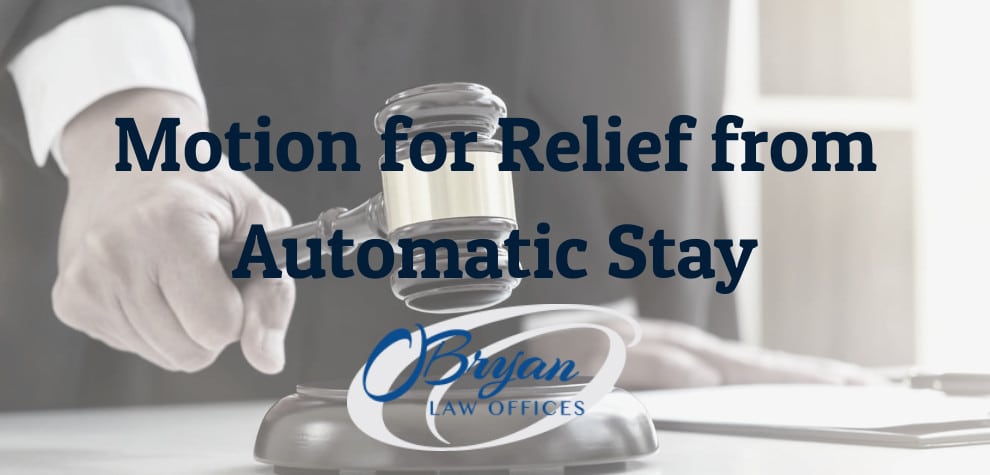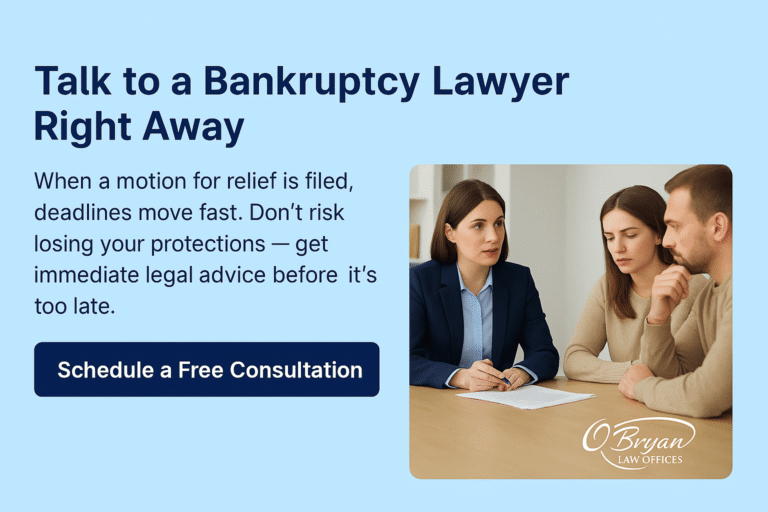A motion for relief from stay, sometimes called a motion to lift stay, is a formal request a creditor makes during a bankruptcy case. By filing this motion, the creditor is essentially asking the court for permission to move forward with certain collection actions against a debtor’s property—despite the automatic stay.
The automatic stay is a powerful legal protection that begins the moment bankruptcy is filed, halting foreclosure proceedings, repossession efforts, wage garnishments, and other collection attempts. Creditors typically seek relief from stay when a debtor has missed payments on secured debts like mortgages or car loans, or when the debtor no longer intends to keep the property tied to the loan.
At O’Bryan Law Offices, our team of experienced bankruptcy attorneys in Louisville helps clients understand and respond to these types of motions every day. If you’ve received notice of a motion for relief from stay, it’s important to act quickly and know your legal rights.
Call us today at (502) 339-0222 to schedule your free consultation and get back on track toward financial stability.
When a Motion for Relief is Filed

The Automatic Stay: Chapter 7, Chapter 11, and Chapter 13
When you file for bankruptcy under Chapter 7, Chapter 11, or Chapter 13, the law immediately provides you with a protection known as the automatic stay. This protection begins the instant your bankruptcy petition is filed with the court—hence the name “automatic.” From that exact timestamp, creditors are legally required to stop all collection activity. This includes phone calls, wage garnishments, foreclosure proceedings, and repossession efforts.
Once the filing is complete, notices are mailed to all of your creditors informing them of the stay. While there can be a short delay as notices reach creditors through the mail, the protection is still legally in place from the moment of filing. If a creditor ignores the stay and continues collection efforts after receiving notice, they risk facing sanctions from the bankruptcy court.
Creditor’s Request
The automatic stay is a powerful shield for debtors, but creditors can challenge it by filing what’s called a motion for relief from stay. This motion is the creditor’s way of asking the court for permission to move forward with actions that would normally be stopped by bankruptcy protections. In most cases, secured creditors—such as mortgage lenders or auto lenders—file these requests when they believe their financial interests are at risk.
For example, if you fall behind on your mortgage payments during bankruptcy, your lender may argue that they should be allowed to resume foreclosure proceedings because the property is collateral for the loan. Similarly, a car lender may request permission to repossess a vehicle if payments are missed. The court will then decide whether the stay should remain in place or be lifted to allow the creditor to proceed.
Examples of Actions
When granted, a motion for relief from stay gives creditors the ability to:
- Resume foreclosure proceedings on a home
- Move forward with repossession of a vehicle
- Take action to seize collateral or enforce liens connected to a loan
While these actions may sound intimidating, debtors still have the opportunity to respond, negotiate, or object with the help of an attorney. The key is to act quickly once a motion has been filed, as deadlines are strict and the outcome can significantly impact your financial future.
Common Reasons for a Motion
Non-Payment on Secured Loans
The most common reason a creditor files a motion for relief from stay is because of missed payments on secured debts. These debts are tied to specific collateral, such as a house or a car. For example, if you file for Chapter 7 bankruptcy but fall behind on your mortgage, your lender may ask the court for permission to resume foreclosure proceedings. The same is true for a car loan—if payments aren’t made on time, the creditor may request repossession of the vehicle.
When creditors file these motions, they are essentially telling the court that the value of the collateral is at risk, and they should be allowed to protect their financial interest by moving forward with collection actions. If you are current on your secured loan payments, however, it is much less likely that a creditor would succeed in getting relief from the automatic stay.
Debtor’s Intent to Surrender Property
Another common reason for filing is when the debtor does not intend to keep certain property during the bankruptcy process. For example, if you plan to surrender your home or return your vehicle, the creditor may file a motion to lift the stay so they can begin foreclosure or repossession sooner. In this situation, the court often grants the motion since the property will eventually go back to the creditor anyway.
Other Financial Considerations
Creditors may also argue for relief from stay if they can show that continuing the automatic stay causes them unfair financial harm. For example, if the debtor has no equity in the property and cannot realistically catch up on payments, the court may determine that allowing the creditor to proceed is fair. Each case is unique, and the judge will weigh both the creditor’s rights and the debtor’s protections before making a decision.
What Happens Next
1. Filing and Service
Once a creditor decides to pursue relief from the automatic stay, they must file a formal motion with the bankruptcy court. This motion is also served on the debtor, the debtor’s attorney, and the bankruptcy trustee to ensure all parties are notified. Proper filing and service are critical—if a creditor fails to follow procedure, the motion can be challenged or denied.
2. Notice and Hearing
After the motion is filed, the court will typically issue a Notice of Motion. This notice outlines the details of the motion and provides the date and time of the scheduled hearing. The hearing gives both the creditor and the debtor (through their attorney) an opportunity to present arguments and evidence before the judge decides whether to lift the stay.
3. Response Time
Debtors have a limited window to respond to the motion, often as short as 14 days. Failing to file a timely response could result in the court granting the creditor’s request automatically. Because the timeframe is so strict, it is important to work with a bankruptcy attorney immediately after receiving notice.
Potential Outcomes
At the end of the hearing, the court may decide in one of several ways:
- Relief Granted – The court allows the creditor to move forward with foreclosure, repossession, or other collection actions.
- Negotiated Agreement – The debtor and creditor may reach a compromise, such as a payment plan or loan modification, that resolves the motion without lifting the stay.
- Motion Denied – The court may rule in favor of the debtor if the creditor failed to follow proper procedure or if the debtor shows a valid reason for the stay to remain in place (for example, a pending reorganization plan or loan modification).
To better understand how this process works in practice, here’s a simple breakdown of the key steps in a motion for relief from stay and why each step matters:
| Step in the Process | What It Means for the Debtor | Why It Matters |
|---|---|---|
| Filing & Service | Creditor submits the motion and notifies all parties. | Ensures legal due process. |
| Notice & Hearing | Debtor receives hearing details and has a chance to respond. | Provides opportunity to defend or negotiate. |
| Response Window | Typically 14 days to reply. | Missing the deadline can result in the automatic stay being lifted. |
| Possible Outcomes | Relief granted, motion denied, or negotiated settlement. | Determines whether the creditor can resume collection actions. |
How to Fight a Motion for Relief from the Automatic Stay

To fight a motion for relief from the automatic stay, you (and your attorney) must act quickly and file a timely response with the court. This gives you the chance to challenge the creditor’s request, present defenses, or negotiate an alternative solution. While receiving notice of such a motion may feel overwhelming, remember that you have the legal right to oppose it, and the bankruptcy court will not lift the stay without giving you an opportunity to be heard. Generally, objections fall into two categories: procedural and substantive.
1. Procedural Objections
A procedural objection challenges the way the creditor filed the motion rather than the reason behind it. These objections focus on whether the creditor followed the proper rules. Examples include:
- Improper service: If the creditor fails to send notice of the motion to you and your attorney.
- Lack of notice for hearing: If you were not given sufficient time to prepare for your hearing.
- Missing documentation: If the creditor does not attach required documents (like loan agreements or account records) to support their claim.
Even small mistakes on the creditor’s part can be enough for your attorney to request that the court deny the motion.
2. Substantive Objections
A substantive objection challenges the actual content of the creditor’s motion. These arguments require a deeper understanding of the Bankruptcy Code and typically rely on evidence about your financial situation or bankruptcy plan. Common substantive defenses include:
- Active reorganization plan: You have filed or confirmed a repayment plan under Chapter 13 that will address the creditor’s debt.
- Loan modification agreement: You have applied for or received a loan modification that reduces your monthly payments, showing good faith effort to remain current.
- Lack of creditor harm: You are current on payments, or the creditor cannot prove that their financial interests are at risk.
Substantive objections are often more complex than procedural ones, but they can be powerful if you and your attorney provide strong evidence.
What Happens After the Automatic Stay Is Lifted
If the court grants a creditor’s motion, the creditor can move forward with actions such as foreclosure, repossession, or eviction. While this may feel overwhelming, you still have options to reduce the impact. Reaching out to the creditor can help you negotiate a move-out date, voluntary surrender, or even a payment plan to avoid sudden disruptions.
A key benefit of surrendering property during bankruptcy is that any deficiency balance (the amount still owed after a foreclosure sale or repossession) is usually discharged. Outside of bankruptcy, however, you could remain liable for that balance. In rare cases, if the creditor recovers more than what is owed, you may be entitled to claim a portion of the proceeds.
How Long Does the Automatic Stay Remain in Effect
The automatic stay begins immediately when you file for bankruptcy, but how long it lasts depends on your past filings.
- No prior dismissals in the past year: The stay remains in effect until your case is discharged or closed.
- One prior dismissal in the past year: The stay lasts only 30 days unless extended by the court.
- Two or more dismissals in the past year: No automatic stay applies unless you request it and the court grants it.
These timelines are critical because the automatic stay provides vital protection from creditor actions. An attorney can review your situation to determine whether you qualify for the full stay or if additional steps are needed to extend it.
Importance of Legal Counsel
Dealing with a motion for relief from stay adds another layer of stress to an already difficult financial situation. You don’t have to go through it alone. At O’Bryan Law Offices, our experienced bankruptcy attorneys in Louisville focus exclusively on helping clients through bankruptcy cases, giving us the knowledge and skill to protect your rights and guide you toward relief.
Whether you’re dealing with foreclosure, repossession, or other creditor actions, our team is ready to guide you through the process and help you work toward a fresh start.
Call us today at (502) 339-0222 for a free consultation and take the first step toward regaining control of your finances.
Frequently Asked Questions
An order granting a motion for relief from stay means the bankruptcy court has allowed the creditor to move forward with certain collection actions that were previously stopped by the automatic stay. This could include resuming foreclosure, repossession, or other actions against property used as collateral for a loan.
In Chapter 7 bankruptcy, a creditor may file a motion for relief from stay if you fall behind on secured debts such as a mortgage or car loan, or if you plan to surrender the property. If granted, the creditor can continue with foreclosure or repossession while your bankruptcy case is still active.
In Chapter 13 bankruptcy, a creditor may request relief from the automatic stay if you stop making required plan or loan payments. Since Chapter 13 is designed to let you catch up on arrears over time, creditors often argue for relief when they believe their collateral (like a home or vehicle) is not being adequately protected.
Creditors can file a motion for relief from stay at any point during the bankruptcy case. However, once the motion is filed, debtors usually have a short response window—often 14 days—to file an objection. Missing this deadline can result in the court automatically granting the creditor’s request.




